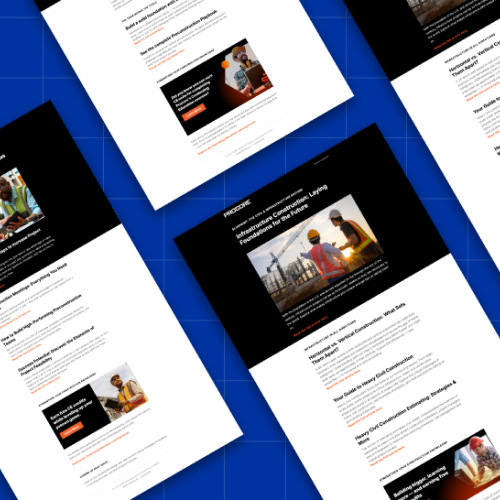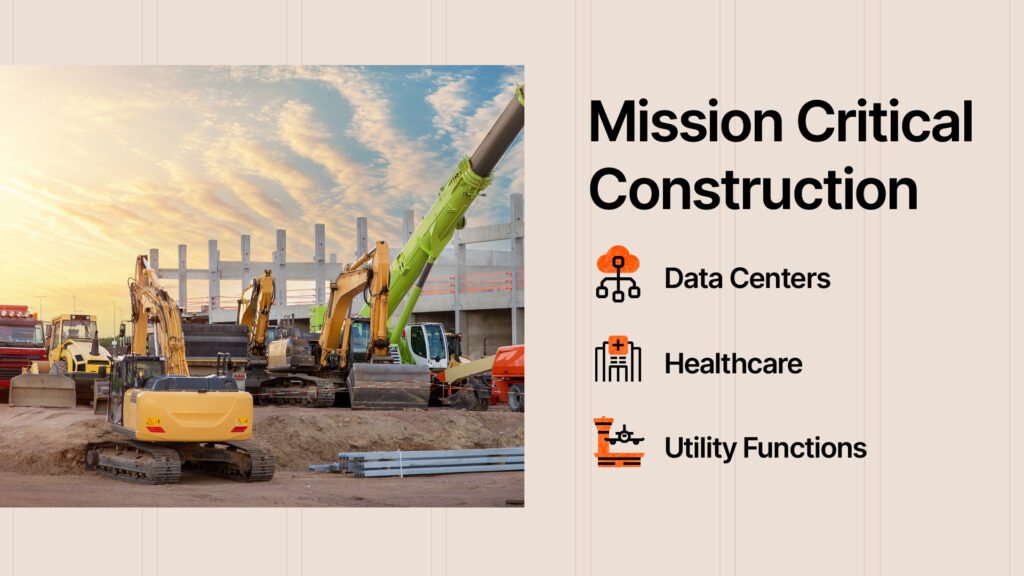— 20 min read
Crafting a Winning Proposal: Step-by-Step Guide
Last Updated Mar 12, 2025
Last Updated Mar 12, 2025

Winning a construction project requires more than proving the capability to complete the work. Success comes from demonstrating the right fit — highlighting how the team’s expertise, approach and experience align with the client’s mission, values and long-term vision. In a competitive environment where proposals responding to Requests for Proposals (RFPs) often look similar, owners and clients are becoming more discerning, seeking partners who meet technical requirements while also understanding and prioritizing their broader project goals.
A well-crafted proposal serves as a powerful tool to make that case. Beyond meeting RFP requirements, a winning proposal tells a compelling story—one that connects experience, approach and team strengths directly to the client’s objectives. While compliance opens the door, strategic alignment and thoughtful storytelling secure the win.
This guide outlines key steps for crafting proposals that stand out. From addressing submission requirements and clarifying client priorities, to selecting relevant project experience and outlining execution strategies, each plays a role in demonstrating value beyond the build.
Table of contents
1. Start with the Basics: Know the RFP Inside Out
A winning proposal starts with a complete understanding of the RFP. Beyond simply reviewing requirements, successful teams dissect every detail to uncover what the client truly values. The RFP provides a roadmap — outlining submission expectations and offering insights into how the client will evaluate submissions.
Taking the time to analyze the RFP thoroughly supports a final proposal that is both compliant and aligned with the client’s goals.
Submission Logistics
Submission logistics form the backbone of the proposal schedule. Confirming due dates, submission formats and production requirements early is essential. Some RFPs may call for electronic submissions, which simplify logistics, while others may require hard copies.
Hard-copy submissions can significantly impact internal timelines, as printing, binding and custom elements like tabs or covers often extend production time. These additional steps must be factored into the schedule from the outset to avoid rushed production that can compromise quality or compliance. Teams that plan for these details early avoid last-minute surprises that can disrupt the submission process.
Understand Proposal Structure
Not all RFPs are created equal. Understanding the proposal structure helps determine how to allocate resources and focus efforts. Beyond simply reviewing section requirements, careful attention should be given to the evaluation criteria and point allocation, as these reveal what the client values most in the selection process. Some RFPs are:
- Qualifications-based: Emphasizing team experience and past performance.
- Approach-focused: Concentrating on execution strategies, logistics and technical expertise.
- Cost-driven: Prioritizing budget alignment and value engineering opportunities.
The way an RFP is structured should guide internal planning and resource allocation. For instance, approach-focused proposals often require detailed technical narratives, logistical plans and visuals, which demand more collaboration and back-and-forth between the marketing and technical teams. In contrast, qualifications-driven proposals may require more effort in tailoring narratives that showcase relevant project experience and team credentials.
Pro Tip
The Importance of a Cover Letter
The cover letter provides an opportunity to connect the proposal to what matters most to the client. It should highlight how the proposed team’s strengths support the client’s broader objectives. Framing the proposal around the unique value of a team transforms the submission from a technical response into a compelling case for partnership.
Client Research
While the RFP outlines technical requirements, it often hints at deeper priorities tied to the client’s mission, values and vision. Conducting client research strengthens the proposal, allowing it to align with the client’s broader goals rather than just meeting baseline requirements. Understanding what drives the client allows for messaging that resonates, creating a proposal that feels tailored rather than generic.
Understanding client priorities and how different sections contribute to the overall score allows the pursuit team to focus their effort where it will have the greatest impact. This strategic focus increases the likelihood of delivering a proposal that resonates with evaluators and stands out in a competitive field.
2. Kickoff Meeting: Laying the Foundation for Success
The kickoff meeting sets the tone for a successful proposal. It provides the opportunity to align the team, clarify expectations and establish a plan that drives the proposal process forward efficiently. A well-structured kickoff meeting lays the groundwork for creating a cohesive submission that meets RFP requirements and also highlights the unique value the team brings to the project.
Set the Stage with the Right Conversations
The first step is to define internal milestones, confirm key deadlines and discuss submission logistics. Factoring these logistical elements into the schedule early prevents last-minute complications that can derail the process.
Clear roles and responsibilities must also be established. Identifying who is responsible for drafting each section of the proposal and confirming team availability reinforces accountability. A proposal’s success depends on the collaboration of both marketing and technical teams, so aligning schedules and expectations from the start is key.
The kickoff meeting is also the moment to revisit pre-positioning efforts. By the time an RFP is released, prior conversations with the client should have revealed insights into their priorities, challenges and decision-making processes. Discussing these insights helps shape a proposal that resonates with the client’s mission, values and pain points. Understanding what matters most to the client allows the team to tailor messaging and strategy accordingly, weaving those themes consistently throughout the proposal.
Dive into the Proposal Workbook & Checklist
A comprehensive proposal workbook serves as the single source of truth for the entire submission process. This master tracking document keeps the team aligned so that no detail is overlooked. It should include:
Section Responsibilities
Clearly define which team members own each section, from technical narratives to executive summaries.
Page Allocations
Assign page limits by section to maintain focus and comply with RFP requirements.
Submission Formatting Rules
Document guidelines related to font size, margins, tab requirements and other formatting specifications.
Final Milestone Deadlines
Establish internal deadlines for drafts, reviews and final production, working backward from the RFP submission date.
By centralizing this information, the proposal workbook eliminates ambiguity, streamlines collaboration and supports consistency. As the proposal evolves, the workbook remains the reference point that keeps the team focused and organized.
3. Clarify the Client’s Priorities
Much of the information needed to craft a winning proposal should already be gathered before the RFP is released. The most competitive submissions are built on a foundation of pre-positioning— a strategic process that involves engaging with the client early, well ahead of formal procurement. This involves building relationships, understanding the client’s mission and values, identifying potential project goals and challenges and demonstrating understanding in areas that matter most to the client.
By the time an RFP is issued, these details should already be clear, providing a competitive edge and allowing the proposal to align with what the client truly values.
However, when an RFP lacks key details, clarifications may be necessary — but they should be approached strategically.
Ask Strategic Questions Thoughtfully
If an RFP is unclear on key aspects — such as submission requirements, scope details or evaluation criteria — submitting well-considered questions is essential. Confirming submission format, page limits and production specifications maintains compliance, while clarifying evaluation criteria helps shape a more targeted response.
Pro Tip
The strongest proposals are built on insights gathered well before the RFP is issued. When clarification is necessary, focus on procedural or compliance-related details rather than questions that could inadvertently reveal strategy or gaps in knowledge to competitors. Thoughtful, well-timed inquiries ensure a fully informed response without compromising a competitive edge.
A thorough early review of the RFP — including contractual terms and potential risks — assures that any necessary questions are identified and submitted before the client’s deadline, leaving sufficient time to incorporate these clarifications into the proposal.
Balancing the Need for Clarity with Strategic Considerations
Seeking clarification can provide valuable insights, but it must be done strategically. Questions submitted during the RFP process are typically shared with all bidders. Revealing too much interest in a particular approach or challenge could inadvertently give competitors an advantage. Therefore, only essential clarifications should be requested — focusing on points that directly affect compliance or important aspects of the proposal. When necessary, framing questions carefully — without signaling gaps in knowledge or strategy — helps the team gather useful information without compromising its competitive position.
4. Differentiate: Moving Beyond Compliance to Compelling
Meeting RFP requirements is the baseline for consideration, but it’s not enough to win the project. While compliance assures that a proposal stays in the running, it doesn’t guarantee selection. To stand out, a proposal must move beyond simply meeting specifications and tell a compelling story — one that answers the central question: Why this team?
Differentiation comes from tailoring every section of the proposal to reflect a deep understanding of the client’s unique challenges and demonstrating the ability to solve them. By blending strategic messaging with relevant project experience and proven results, a proposal transforms from a standard submission into a persuasive argument for partnership.
From Compliant to Compelling
A compliant proposal checks every box outlined in the RFP — meeting formatting guidelines, addressing all required sections and following submission instructions. However, compliance alone positions a proposal among many similar responses. The key to standing out is alignment — structuring every section to answer the client’s questions as well as build a clear case for why this team is the best choice.
Every narrative should be tailored to the client’s priorities, avoiding generic, boilerplate language. Standard qualifications may demonstrate capability, but tailored messaging shows commitment and understanding. A strong proposal connects the team’s experience, approach and expertise to the client’s goals, shifting the response from a technical submission to a strategic solution.
Demonstrate Expertise with Stories
Case studies, lessons learned and client testimonials provide tangible proof of a team’s ability to deliver results. Rather than simply listing past projects, effective proposals explain how challenges were overcome, reinforcing the team’s problem-solving approach and strategic thinking.
These examples do more than illustrate competence — they directly address why this team is the right fit for the project. A proposal that weaves real results, strategic problem-solving and client-centered solutions into its narrative moves beyond compliance, making a compelling case for selection.
5. Select Past Projects Strategically
The right past projects strengthen a proposal by proving the team’s ability to deliver under similar conditions. Many firms may have comparable experience on paper, but how that experience is presented makes the difference. Instead of listing completed projects, the most compelling proposals show measurable success — demonstrating not just what was built, but how challenges were solved in ways directly relevant to the client’s needs.
Align Experience with Client Needs & Requirements
Project selection should be intentional, focusing on those that reflect the scope, constraints and complexity of the current opportunity. Projects that align with the client’s challenges—whether working on an occupied campus, meeting a fast-track schedule or managing phased construction—build confidence in the team’s ability to replicate that success.
Most RFPs define eligibility criteria, such as:
- Completed within a specific timeframe (e.g., “within the last 5 years”).
- Meeting a minimum construction value (e.g., “projects valued over $X million”).
- Featuring specific project types, such as healthcare facilities, educational campuses or historic renovations.
Selecting projects that meet these criteria is only the starting point. The real differentiator comes from showcasing how those projects addressed similar client goals or overcame comparable challenges.
Tell Results-Focused Stories
Project descriptions should go beyond scope, schedule and budget to emphasize outcomes. What problems were solved? What measurable impact was achieved? Results-driven storytelling turns past performance into a clear, compelling case for why this team is the right choice.
Instead of merely stating project details—scope, schedule and budget—illustrate how specific actions led to measurable success. For example:
- Accelerated schedules: Describe how proactive scheduling or alternative phasing plans reduced construction timelines.
- Cost savings: Highlight how collaborative value engineering efforts brought projects back on budget without compromising quality.
- Innovative solutions: Share how unique construction methodologies, such as prefabrication or modular construction, minimized disruptions or addressed labor shortages.
These types of stories demonstrate technical expertise while also illustrating the ability to solve problems that matter to the client. By showcasing how similar challenges were met and outcomes achieved, proposals demonstrate a clear capability to deliver—reinforcing why this team is the right choice for the job.
Build a Strong Foundation with our Preconstruction Course
With 20+ years of experience, Ben Ashburn teaches you how to streamline planning, bidding, and procurement for better outcomes.

6. Craft an Approach Section That Shows Delivery Confidence
The approach section is one of the most scrutinized parts of a proposal. It outlines how the project will be executed, demonstrating technical expertise and an understanding of the project’s unique challenges. A well-crafted approach section provides clear, actionable strategies for delivering the project efficiently, safely and in alignment with the client’s broader objectives.
Focus on Logistics and Execution
A strong approach section highlights the execution strategy in detail. Key components include:
- Phasing plans that outline how different stages of construction will be sequenced to minimize disruptions and maintain operational continuity
- Accessing strategies that define how construction traffic, materials and personnel will move throughout the site safely and efficiently
- Site logistics plans detailing construction zones, laydown areas, muster points and temporary facilities
- Risk mitigation methods that proactively address potential challenges such as weather delays, procurement risks or working in occupied environments
Complex logistics sections are often a deciding factor in evaluating proposal submissions, particularly when the project involves phased occupancy, restricted site access or operational timelines.
Pro Tip
Technical sections carry the most weight when directly tied to client priorities. Instead of just explaining a phasing plan, show how it accelerates occupancy, minimizes disruptions or cuts costs—demonstrating not just execution, but measurable impact. Clear connections between strategy and results make technical expertise a decisive factor in selection.
Balance Technical Detail with Accessibility
The approach section must balance technical rigor with clarity. While technical evaluators may focus on construction methodologies, broader selection committees, including non-technical stakeholders, will be interested in understanding how these approaches contribute to overall project success.
Explanations of technical processes should be clear and concise, avoiding overly complex language that could alienate non-technical readers. When describing technical details — such as BIM integration, prefabrication strategies or specialized construction techniques — it is essential to connect these details to outcomes that matter.
7. Address Cost with Transparency and Strategy
Cost plays an important role in proposal evaluations, but securing a project requires more than presenting the lowest figure. Clients seek confidence that the selected team can deliver the project within the established budget while maintaining quality and schedule expectations. A strong cost section goes beyond basic estimates, demonstrating a strategic approach to cost management, risk mitigation and value creation throughout the project lifecycle.
More Than the Lowest Number
The most competitive proposals demonstrate a clear understanding of cost management that extends beyond the initial estimate. Successful cost strategies incorporate:
Pro Tip
Not all owners are solely focused on the lowest bid. They want assurance that the project will be managed to the agreed upon budget without unexpected cost overruns. Demonstrating an ability to manage costs throughout preconstruction and construction phases reassures clients that financial risks are understood and controlled.
- Partnership during preconstruction: Collaborating with clients, designers and key stakeholders early in the process to align scope, schedule and budget. This partnership builds trust and ensures that cost decisions support project goals.
- Cost alignment processes: Developing budgets that reflect realistic market conditions and project requirements. Transparent explanations of how estimates were developed, including assumptions and contingencies, provide clarity and build client confidence.
- Value engineering (VE) opportunities: Identifying alternatives that reduce costs without compromising functionality, aesthetics or performance. Effective VE solutions demonstrate problem-solving abilities and a commitment to meeting client objectives.
Highlight Risk Mitigation
Cost proposals gain credibility when paired with thoughtful risk mitigation strategies. Addressing potential risks shows foresight and positions the team as a proactive partner. Key risk mitigation elements include:
- Early procurement strategies: Identifying long-lead items — such as elevators, specialized equipment or custom materials — and detailing plans for early procurement to avoid schedule disruptions and cost escalations.
- Market risk analysis: Highlighting awareness of current market volatility, material price fluctuations and labor availability, along with plans to minimize their impact.
- Supply chain resilience: Outlining relationships with reliable suppliers and subcontractors to maintain project continuity, even when market conditions shift.
Potential risks should be framed as opportunities to demonstrate expertise. For example, acknowledging the lengthy lead times for essential equipment and outlining a plan to initiate procurement immediately upon contract award signals a proactive, solution-oriented approach. By addressing risks head-on and offering solutions, the proposal shows the awareness as well as the capability to manage complex project dynamics.
8. Emphasize Team Experience and Fit
The strength of a proposal lies in the firm’s overall qualifications as well as the experience and cohesion of the proposed project team. Clients are placing greater emphasis on the individuals who will manage and execute the work, seeking assurance that the team possesses the right experience, expertise and working relationships to deliver the project successfully. Demonstrating that the proposed team has both the technical capabilities and proven collaboration experience can be a decisive factor in the selection process.
Prove the Team’s Relevance
A compelling proposal highlights why this team — not just the firm — is the right choice for the project. Selection committees want to see professionals whose experience aligns directly with the project’s scope, challenges and priorities. Instead of relying on firm-wide credentials, this section should focus on how the proposed team has successfully handled similar constraints and objectives.
Showcase Individual Strengths
Each key team member should be introduced with a focus on how their expertise directly benefits the project. Rather than simply listing roles, this section should highlight the key strengths and leadership qualities that set each individual apart.
- Demonstrated leadership: Highlighting team members who have successfully led similar projects, showcasing their ability to drive schedules, manage risks and maintain quality.
- Technical expertise: Calling out specialized knowledge in areas central to the project, such as complex MEP systems, phased construction or sustainability initiatives.
- Strategic problem-solving: Providing examples of how team members have handled project challenges.
After establishing high-level strengths, the resume section should include detailed credentials, project experience and key contributions for each individual. Resumes should reinforce the messaging presented here, delivering a cohesive narrative that demonstrates why this team is the best choice for the project.
Highlight Team Cohesion
Beyond individual expertise, clients want assurance that the team functions well as a unit. Emphasizing past collaborations between team members reduces perceived onboarding risks by showing that working relationships are already established. Teams that have successfully delivered similar projects together are more likely to communicate effectively, resolve issues quickly and maintain project momentum.
When possible, include examples of previous projects where members of the proposed team worked together to overcome challenges or achieve key milestones. Highlighting these shared successes provides concrete evidence of the team’s ability to perform cohesively under similar project-specific conditions.
9. Present a Realistic, Client-Centric Schedule
A well-constructed schedule is more than just dates and a timeline — it is a demonstration of how the project will be delivered efficiently, with minimal disruptions and aligned with the client’s key objectives. The schedule section should reflect a clear understanding of project priorities, showing thoughtful planning that balances client needs, construction realities and potential risks. A client-centric schedule outlines when tasks will occur while also instilling confidence in the ability to deliver on time and within budget.
Focus on High-Level Milestones
Most clients are less concerned with detailed daily schedules and more focused on understanding key project milestones. Presenting a clear outline of high-level milestones makes the schedule easier to digest and highlights important points in the project timeline. Essential milestones may include:
- Permitting approvals
- Groundbreaking ceremonies
- Major construction phase completions
- Final inspections and occupancy readiness
Dense Gantt charts, while valuable for technical reviewers, can be overwhelming for broader selection committees. These detailed schedules can be included as appendices for reference, while the main proposal should focus on summarizing milestones that demonstrate a clear and achievable path to project completion.
Demonstrate Critical Path Thinking
An effective schedule shows a deep understanding of the project’s critical path—the sequence of tasks that directly impact the overall project timeline. Demonstrating critical path thinking involves working backward from key occupancy or delivery dates to verify that all activities align with client expectations.
By illustrating how key dependencies are managed, such as procurement of long-lead items or coordination of specialty subcontractors, the schedule reflects a proactive approach to avoiding delays. Critical path analysis also shows foresight in identifying potential bottlenecks and the strategies in place to mitigate them.
Introduce Alternative Scheduling Ideas
Schedules that demonstrate flexibility and creativity often stand out. Alternative scheduling strategies can provide clients with options that reduce costs, shorten timelines or minimize operational disruptions. Presenting such alternative scheduling ideas highlights problem-solving capabilities as well as shows a willingness to tailor solutions to the client’s priorities.
A realistic, client-centric schedule focuses on the milestones that matter most, demonstrates critical path understanding and offers innovative scheduling solutions that add value. By presenting a schedule that reflects both technical expertise and alignment with the client’s needs, the proposal builds confidence in the team’s ability to deliver a successful project — on time and with minimal disruption.
Stay updated on what’s happening in construction.
Subscribe to Blueprint, Procore’s free construction newsletter, to get content from industry experts delivered straight to your inbox.

10. Final Quality Control: The Last 10% That Wins
The final stage of proposal development is often what separates a winning submission from the rest. While content, strategy and storytelling are essential, the last 10% of effort—focused on polishing and perfecting the proposal—can make the decisive difference. A thorough quality control process assures a polished, well-structured proposal that leaves a lasting impression on evaluators.
Consistency and Cohesion
Proposals developed by multiple contributors can suffer from inconsistencies in tone, terminology and messaging. To create a seamless, unified submission, a single individual—typically the marketing lead—should own the final narrative. Their role includes:
- Aligning tone: Maintaining a single, professional voice throughout the proposal.
- Standardizing terminology: Keeping technical terms, project names and client references consistent.
- Reinforcing messaging: Integrating key themes, differentiators and value propositions are consistently integrated.
A cohesive narrative strengthens persuasiveness, making the proposal feel intentional and well-structured rather than assembled from multiple sources.
Leadership Review: Validating Strategy and Key Details
Before submission, executive leadership—such as the project executive or principal-in-charge—should conduct a high-level strategic review. This check confirms that the proposal reflects the firm’s win strategy, approach and key messaging, while also verifying key details such as:
- Terms and conditions: Verifying that contract language aligns with firm policies and risk considerations.
- Fees and financials: Confirming all cost data is accurate and properly structured.
- Overall strategic alignment: Evaluating whether the proposal clearly communicates why this team is the best choice.
Final Compliance & Quality Checks
While leadership focuses on strategic alignment, the marketing lead is responsible for the final quality control process. This includes:
- Spell check & grammar review: Eliminating typos and formatting errors.
- Page numbering & document structure: Verifying pagination, section order and formatting consistency.
- RFP compliance: Confirming all submission requirements, including formatting, page limits and required content, are met.
- Final content check: Verifying that all RFP requirements are met and every client question is fully addressed.
This review is designed to catch the small but important issues that could undermine the proposal’s professionalism. It also provides an opportunity for leadership to validate strategic alignment and messaging before the final handoff. This attention to detail at the final stage often makes the difference between being considered and being chosen.
Securing the Win
A winning proposal does more than check the right boxes—it tells a strategic, client-focused story that demonstrates why the team is the best fit for the project. While compliance assures a proposal stays in the running, it’s the ability to connect experience, approach and execution strategy to the client’s priorities that sets a submission apart.
From understanding the RFP and clarifying client priorities to selecting relevant past projects, crafting a strong execution plan and refining the final submission, every step in the proposal process plays a role in making a compelling case. A well-structured, polished proposal positions the team as a trusted partner—one that meets project requirements and delivers lasting value.
Was this article helpful?
Thank you for your submission.
0%
0%
You voted that this article was . Was this a mistake? If so, change your vote here.
Scroll less, learn more about construction.
Subscribe to The Blueprint, Procore’s construction newsletter, to get content from industry experts delivered straight to your inbox.
By clicking this button, you agree to our Privacy Notice and Terms of Service.
Categories:
Tags:
Written by
Taylor Riso
73 articles
Taylor Riso is a marketing professional with more than 10 years of experience in the construction industry. Skilled in content development and marketing strategies, she leverages her diverse experience to help professionals in the built environment. She currently resides in Portland, Oregon.
View profileExplore more helpful resources

Mission Critical Construction: Strategies for Success
Mission critical construction involves building structures whose functions cannot afford to fail, as any disruptions can lead to significant consequences for society. Keeping data centers, hospitals, power plants and other...

Modular Construction and MEP: A Collaborative Pairing
In an age of supply chain disruptions, workforce shortages, and rising material costs, off-site construction — including modular construction methods and prefabricated materials — is surfacing as a multipurpose solution....

Connected Construction: Transforming the Industry Through Integration
Construction projects are becoming increasingly complex, so companies need to innovate to accurately and profitably complete these modern structures. Connected construction — using technology and data to improve communication, processes...

Off-Site Construction: Prefab vs. Modular
As the construction world becomes ever more competitive, deadlines get tighter and the margin for error gets slimmer, project owners around the world are always looking for an edge. Thanks...